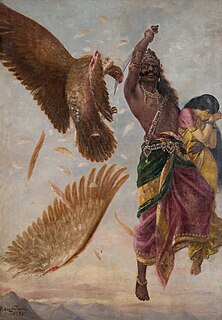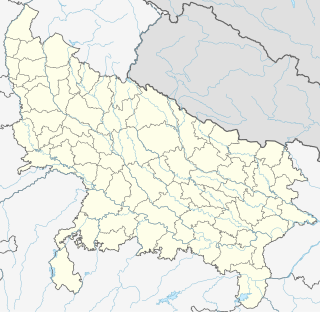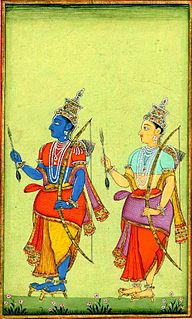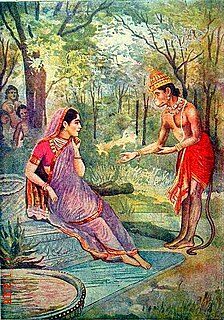 W
WRamayana is one of the two major Sanskrit epics of ancient India, the other being the Mahābhārata. Along with the Mahābhārata, it forms the Hindu Itihasa.
 W
WAdam's Bridge, also known as Rama's Bridge or Rama Setu, is a chain of limestone shoals, between Pamban Island, also known as Rameswaram Island, off the south-eastern coast of Tamil Nadu, India, and Mannar Island, off the north-western coast of Sri Lanka. Geological evidence suggests that this bridge is a former land connection between India and Sri Lanka.
 W
WAdityahridayam is a Hindu devotional hymn dedicated to Āditya or Sūrya found in the Yuddha Kānda (6.105) of Vālmīki's Rāmāyana. It was recited by the sage Agastya to Rāma in the battlefield before fighting with the asura king Rāvaṇa. In it, Agastya teaches Rāma the procedure of worshiping Āditya to defeat the enemy.
 W
WAraṇya-Kāṇḍa or The forest episode is the third chapter of the epic poem Rāmcaritmānas written by Tulsidas.
 W
WBaal Kaand is the first book of the Valmiki Ramayana, which is one of the two great epics of India.
 W
WKecak, known in Indonesian as tari kecak, is a form of Balinese hindu dance and music drama that was developed in the 1930s in Bali, Indonesia. Since its creation, it has been performed primarily by men, with the first women's kecak group having started in 2006. The dance is based on the story of the Ramayana and is traditionally performed in temples and villages across Bali.
 W
WLakshmana Rekha, in some later versions of Ramayana, is a line drawn by Lakshmana around the dwelling he shares with his brother Rama and Rama's wife Sita at Panchavati in the forest of Dandakaranya which now part of the city of Nashik in Maharashtra. The line is meant to protect Sita, while he is away searching for Rama. Ramacharitamanas, the popular North Indian rendering of story of Rama, does not feature the Lakshmana Rekha story in the Aranya Kanda. Neither does the original, the Valmiki Ramayana. However, in Lanka Kanda of the Ramcharitmanas, (35.1) Mandodari rebukes Ravana on his boisterous claims of valour by hinting that his claim of strength and valour is shallow for he could not even cross a small line drawn by Shri Rama's younger brother Lakshmana.
 W
WMakhauda Dham is one of the most ancient places of Harraiya tehsil in Basti district where Raja Dashrath performed yagya with the help of Sage Rishyasringa on the advice of Vashistha. Name of Yajna was the Putrakameshti. It is said that Dasharatha and Kaushalya has a daughter Shanta, who was Rishyashringa's wife. As the conclusion of the Yagya drew near Agni sprang out from the yagnakunda and handed Dasharatha a pot of kheer advising him to distribute it among his queens. Kaushalya ate half the kheer, Sumitra ate a quarter of it. Kaikeyi ate some and passed the pot back to Sumitra who consumed the kheer a second time.
 W
WNaimiṣāraṇya, also referred as Naimisha is a sacred forest frequently mentioned in Puranic literature as well as both the Ramayana and the Mahabharata. It is the place where Puranas had been narrated for the first time before a large gathering of sages.The place proper was undoubtedly of much religious efficacy as it was the abode of sixty-thousand Ṛṣis.
 W
WRamayana Ballet Prambanan is a visualization of Kakawin Ramayana, Javanese version of Ramayana story, performed near the Prambanan temple, Indonesia. The Ramayana Ballet at the Prambanan isn't like the Western ballet performance, It's more like the Wayang wong.
 W
WRam Janmabhoomi is the name given to the site that is believed to be the birthplace of Rama, the seventh avatar of the Hindu deity Vishnu. The Ramayana states that the location of Rama's birthplace is on the banks of the Sarayu river in a city called "Ayodhya".
 W
WRama (Rāma), the hero of Ramayana, is described in the Jain scriptures as one of sixty-three illustrious persons, known as Salakapurusa. Among these, there are nine sets of Balabhadra, Vasudeva and Prati-Vasudeva. Rama was the 8th Balabhadra with Lakshmana and Ravana being his Vasudeva and Prati-Vasudeva counterparts. He is described as a young prince who is deprived of his throne and turned into a pauper. While living in exile his wife Sita is kidnapped by Ravana, King of Lanka. Rama then rescues Sita with the help of his brother Lakshmana and King Sugriva. Ravana is killed by Lakshmana and they both go into hell. Rama becomes a Jain monk and his soul attains moksha. Sita becomes a Jain nun and is born into heaven as Indra.
 W
WRama Navami is a spring Hindu festival that celebrates the birthday of the Hindu God Lord Rama. He is particularly important to the Vaishnavism tradition of Hinduism, as the seventh avatar of God Vishnu. The festival celebrates the descent of Vishnu as shri Rama avatar, through his birth to King Dasharatha and Queen Kausalya in Ayodhya. The festival is a part of the spring Navratri, and falls on the ninth day of the bright half in the Hindu calendar month of Chaitra. This typically occurs in the Gregorian months of March or April every year. Rama Navami is an optional government holiday in India.
 W
WThe Ramakien is one of Thailand's national epics, derived from the Hindu epic Ramayana.. Ramakien is an important part of Thai literary canon.
 W
WThe Ramayana Ballet is a visualization and representation of the epic Ramayana saga, originally written by Valmiki in the Sanskrit language, in a highly stylized dance artform. Ramayana Ballet performance combines music, dance and drama, usually performed without dialogue.
 W
WRamrekha Mandir is an ancient Hindu temple of Lord Ram and Goddess Sita.
 W
WRobam Sovann Maccha is a traditional Cambodian dance. It narrates the encounter of Hanuman and Sovann Maccha during the construction of the causeway to Lanka in Reamker, a Cambodian version of Indian epic Ramayana.
 W
WSundara Kaanda, is the fifth book in the Hindu epic, the Ramayana. The original Sundara Kanda is in Sanskrit and was composed by Valmiki, who was the first to scripturally record the Ramayana. Sundara Kanda is the only chapter of the Ramayana in which the hero is not Rama, but rather Hanuman. The work depicts the adventures of Hanuman and his selflessness, strength, and devotion to Rama are emphasized in the text. Hanuman was fondly called “Sundara” by his mother Anjani and Sage Valmiki chose this name over others as the Sundara Kanda is about Hanuman's journey to Lanka.
 W
WValmiki is celebrated as the harbinger-poet in Sanskrit literature. The epic Ramayana, dated variously from the 5th century BCE to first century BCE, is attributed to him, based on the attribution in the text itself. He is revered as Ādi Kavi, the first poet, author of Ramayana, the first epic poem.
 W
WDepending on the methods of counting, as many as three hundred versions of the Indian epic poem, the Ramayana, are known to exist. The oldest version is generally recognized to be the Sanskrit version attributed to the sage Narada, the Mula Ramayana. Narada passed on the knowledge to Valmiki, who authored Valmiki Ramayana, the present oldest available version of Ramayana.